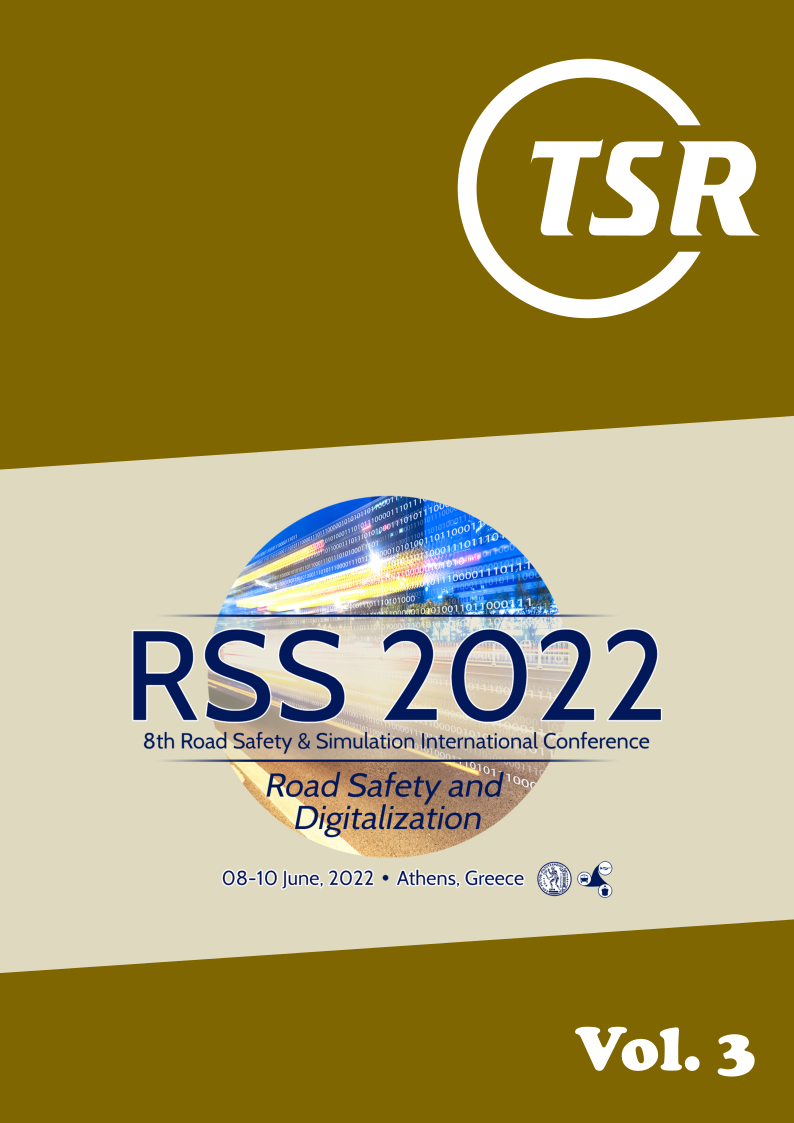Modelling factors that impact the use of child safety seats for nursery school travel
DOI:
https://doi.org/10.55329/kcgl3326Keywords:
child car seats, child restraint systems, preschool children, socioeconomic statusAbstract
Children, as one of the most vulnerable road user groups, are exposed to a high risk of traffic crash-related injuries and fatalities. Children’s incomplete physical and cognitive development leads to inaccurate detection of traffic hazards and inadequate road crossing decisions. When young children travel as car occupants, their body structures are immature, and restraint over larger and sometimes different body areas is necessary. Therefore, children’s vulnerability as car occupants is subject to their age and physical development. This research investigates factors influencing child car seat usage, particularly child restraint systems or booster seats, for commuting to nursery schools. An experimental study was conducted in three suburbs of Athens, Greece, with distinctive socioeconomic status (SES) and built environment characteristics. For this purpose, a self-administered parental questionnaire was completed for 734 children attending municipality nursery schools, exploring the traffic safety practices for preschool children, child-parent interactions, the parent’s risk perception, behaviour, and knowledge of traffic safety. Responses reveal that the surveyed children—irrespective of the residence area—travel to the nursery school mainly as car occupants (89.6% overall, ranging between 84.8% for the area with the lowest SES and 96.1% for the area with the highest SES). In addition, the results indicate that three-quarters of the children are often placed in a car seat, while almost one-quarter are never restrained. Regression and structural equation models are estimated and used to examine factors affecting the usage of child safety seats. Finally, conclusions are drawn, along with suggestions to overcome the limitations and complete this research with ongoing and future data collection and analyses.
Downloads
References
Adminaite, D., G. Jost, H. Stipdonk, et al. (2018), ‘Reducing child deaths on European roads’, presented at European Transport Safety Council PIN Conference (Brussel, Belgium), https://etsc.eu/wp-content/uploads/Reducing-child-road-deaths-on-European-roads-Dovile-Adminaite-ETSC.pdf, accessed 22 October 2022.
Arapoglou, V. P., J. Sayas (2009), ‘New Facets of Urban Segregation in Southern Europe’, European Urban and Regional Studies, 16 (4), 345-362, https://doi.org/10.1177/0969776409340187.
Bilston, L. E., W. Du, J. Brown (2010), ‘Factors predicting incorrect use of restraints by children travelling in cars: a cluster randomised observational study’, Injury Prevention, 17 (2), 91-96, https://doi.org/10.1136/ip.2010.027359.
Brown, J., L. Keay, K. Hunter, et al. (2013), ‘Increase in best practice child car restraint use for children aged 2-5 years in low socioeconomic areas after introduction of mandatory child restraint laws’, Australian and New Zealand Journal of Public Health, 37 (3), 272-277, https://doi.org/10.1111/1753-6405.12070.
Chen, X., J. Yang, C. Peek-Asa, et al. (2014), ‘Parents’ Knowledge, Attitude, and Use of Child Restraints, Shantou, China’, American Journal of Preventive Medicine, 46 (1), 85-88, https://doi.org/10.1016/j.amepre.2013.08.017.
Dunbar, G., V. Lewis, R. Hill (2002), ‘Parent-child interaction and road behaviour: An exploratory study’, British Journal of Developmental Psychology, 20 (4), 601-622, https://doi.org/10.1348/026151002760390972.
Durbin, D. R. (2003), ‘Belt-Positioning Booster Seats and Reduction in Risk of Injury Among Children in Vehicle Crashes’, JAMA, 289 (21), 2835, https://doi.org/10.1001/jama.289.21.2835.
Elliott, M. R., M. J. Kallan, D. R. Durbin, F. K. Winston (2006), ‘Effectiveness of Child Safety Seats vs Seat Belts in Reducing Risk for Death in Children in Passenger Vehicle Crashes’, Archives of Pediatrics & Adolescent Medicine, 160 (6), 617, https://doi.org/10.1001/archpedi.160.6.617.
ELSTAT (2017), ‘Road fatalities by age, gender, road user type’ (Greece: Hellenic Statistical Authority), https://www.statistics.gr, accessed 22 October 2022.
Emery, K. D., S. G. Faries (2008), ‘The Lack of Motor Vehicle Occupant Restraint Use in Children Arriving at School’, Journal of School Health, 78 (5), 274–279, https://doi.org/10.1111/j.1746-1561.2008.00300.x.
Gehlert, T., C. Hagemeister, T. Özkan (2014), ‘Traffic safety climate attitudes of road users in Germany’, Transportation Research Part F: Traffic Psychology and Behaviour, 26, 326–336, https://doi.org/10.1016/j.trf.2013.12.011.
Hafner, J. W., S. J. Kok, H. Wang, et al. (2017), ‘Child Passenger Restraint System Misuse in Rural Versus Urban Children’, Pediatric Emergency Care, 33 (10), 663–669, https://doi.org/10.1097/pec.0000000000000818.
Hu, L.-t., P. M. Bentler (1999), ‘Cutoff criteria for fit indexes in covariance structure analysis: Conventional criteria versus new alternatives’, Structural Equation Modeling: A Multidisciplinary Journal, 6 (1), 1–55, https://doi.org/10.1080/10705519909540118.
Hunter, K., A. Bestman, M. Dodd, et al. (2020), ‘Overloaded and Unrestrained: A Qualitative Study with Local Experts Exploring Factors Affecting Child Car Restraint Use in Cape Town, South Africa’, International journal of environmental research and public health, 17 (14), 4974, https://doi.org/10.3390/ijerph17144974.
Janet Lennon, A. (2012), ‘Has increasing the age for child passengers to wear child restraints improved the extent to which they are used? Results from an Australian focus group and survey study’, Vulnerable Groups & Inclusion, 3 (1), 14975, https://doi.org/10.3402/vgi.v3i0.14975.
Keay, L., K. Hunter, J. Brown, et al. (2012), ‘Evaluation of an education, restraint distribution, and fitting program to promote correct use of age-appropriate child restraints for children aged 3 to 5 years: a cluster randomized trial’, American journal of public health, 102 (12), e96–e102, https://doi.org/10.2105/AJPH.2012.301030.
Keay, L., K. Hunter, J. Brown, et al. (2013), ‘Child restraint use in low socio-economic areas of urban Sydney during transition to new legislation’, Accident Analysis & Prevention, 50, 984–991, https://doi.org/10.1016/j.aap.2012.08.002.
Koppel, S., C. Muir, L. Budd, et al. (2013), ‘Parents’ attitudes, knowledge and behaviours relating to safe child occupant travel’, Accident Analysis & Prevention, 51, 18–26, https://doi.org/10.1016/j.aap.2012.10.009.
Lam, L. T. (2001), ‘Factors associated with parental safe road behaviour as a pedestrian with young children in metropolitan New South Wales, Australia’, Accident Analysis & Prevention, 33 (2), 203–210, https://doi.org/10.1016/s0001-4575(00)00033-6.
Lee, G., C. N. Pope, A. Nwosu, et al. (2019), ‘Child passenger fatality: Child restraint system usage and contributing factors among the youngest passengers from 2011 to 2015’, Journal of Safety Research, 70, 33–38, https://doi.org/10.1016/j.jsr.2019.04.001.
Ling, X. Y., A. J.-H. Ngeow, M. Grace Sy Tan, D. K.-L. Chan (2021), ‘A survey of parental knowledge, attitude and practice of using child car seat restraints in Singapore, with a systematic review’, BMJ Paediatrics Open, 5, https://doi.org/10.1136/bmjpo-2021-rcpch.130.
MacCallum, R. C., M. W. Browne, H. M. Sugawara (1996), ‘Power analysis and determination of sample size for covariance structure modeling’, Psychological Methods, 1 (2), 130–149, https://doi.org/10.1037/1082-989x.1.2.130.
Macy, M. L., G. L. Freed (2012), ‘Child Passenger Safety Practices in the U.S’, American Journal of Preventive Medicine, 43 (3), 272–281, https://doi.org/10.1016/j.amepre.2012.05.023.
Oakil, A. T. M., L. Nijland, M. Dijst (2016), ‘Rush hour commuting in the Netherlands: Gender-specific household activities and personal attitudes towards responsibility sharing’, Travel Behaviour and Society, 4, 79–87, https://doi.org/10.1016/j.tbs.2015.10.003.
Oxford, L., J. Pollock (2015), ‘How actively do children travel to their pre-school setting?’, Journal of Transport & Health, 2 (2), 151–159, https://doi.org/10.1016/j.jth.2015.02.002.
Pan, S., W. Du, F. Jiang, et al. (2011), ‘Exploring child car passenger safety practices in China: experience from a parental survey in Shanghai’, Injury Prevention, 18 (2), 133–137, https://doi.org/10.1136/injuryprev-2011-040049.
R (n/d), ‘The R Project for Statistical Computing’ (The R Foundation), https://www.R-project.org/, accessed 22 October 2022.
Ramsey, A., E. Simpson, F. P. Rivara (2000), ‘Booster Seat Use and Reasons for Nonuse’, Pediatrics, 106 (2), e20, https://doi.org/10.1542/peds.106.2.e20.
Rok Simon, M., A. Korošec, M. Bilban (2016), ‘The influence of parental education and other socio-economic factors on child car seat use’, Slovenian Journal of Public Health, 56 (1), 55–64, https://doi.org/10.1515/sjph-2017-0008.
Rosseel, Y. (2012), ‘An R Package for Structural Equation Modeling’, Journal of Statistical Software, 48 (2), https://doi.org/10.18637/jss.v048.i02.
Roynard, M., P. Silverans, Y. Casteels, P. Lesire (2014), ‘National roadside survey of child restraint system use in Belgium’, Accident Analysis & Prevention, 62, 369–376, https://doi.org/10.1016/j.aap.2013.08.021.
Schluter, P. J., J. Paterson (2010), ‘Vehicle child restraint usage for Pacific children aged 6 weeks to 4 years: Findings from the Pacific Islands Families study’, Accident Analysis & Prevention, 42 (6), 2075–2081, https://doi.org/10.1016/j.aap.2010.06.020.
Schwebel, D. C. (2017), ‘Children Crossing Streets: The Cognitive Task of Pedestrians Across Nations’, Annals of Global Health, 83 (2), 328–332, http://doi.org/10.1016/j.aogh.2017.04.004.
Shimony-Kanat, S., R. Gofin, A. C. Kienski Woloski Wruble, L. Mann (2017), ‘Do parental decision-making patterns predict compliance with use of child booster seats?’, International Journal of Injury Control and Safety Promotion, 25 (1), 53–57, https://doi.org/10.1080/17457300.2017.1323930.
Simpson, E. M., E. K. Moll, N. Kassam-Adams, et al. (2002), ‘Barriers to Booster Seat Use and Strategies to Increase Their Use’, Pediatrics, 110 (4), 729–736, https://doi.org/10.1542/peds.110.4.729.
Vesentini, L., B. Willems (2007), ‘Premature graduation of children in child restraint systems: An observational study’, Accident Analysis & Prevention, 39 (5), 867–872, https://doi.org/10.1016/j.aap.2006.08.005.
Wang, K., Y. Xu, C. Wang, et al. (2019), ‘A Corrected Goodness-of-Fit Index (CGFI) for Model Evaluation in Structural Equation Modeling’, Structural Equation Modeling: A Multidisciplinary Journal, 27 (5), 735–749, https://doi.org/10.1080/10705511.2019.1695213.
Waygood, E. O. D., M. Friman (2015), ‘Children’s travel and incidental community connections’, Travel Behaviour and Society, 2 (3), 174–181, https://doi.org/10.1016/j.tbs.2015.03.003.
WHO (2018), ‘Global status report on road safety’ (Geneva, Switzerland: World Health Organization), https://apps.who.int/iris/rest/bitstreams/1164010/retrieve, accessed 22 October 2022.
Yannis, G. (2009), ‘Use of child seat in Greece’, presented at Seminar for Child Safety in the car—The Greek Reality (Athens, Greece), https://www.nrso.ntua.gr/geyannis/conf/cp47-use-of-child-seat-in-greece/, accessed 22 October 2022.
Yu, C.-Y., X. Zhu (2013), ‘Impacts of Residential Self-Selection and Built Environments on Children’s Walking-to-School Behaviors’, Environment and Behavior, 47 (3), 268–287, https://doi.org/10.1177/0013916513500959.
Zuniga, K. D. (2012), ‘From barrier elimination to barrier negotiation: A qualitative study of parents' attitudes about active travel for elementary school trips’, Transport Policy, 20, 75–81, https://doi.org/10.1016/j.tranpol.2011.12.003.
Downloads
Published
How to Cite
Issue
Section
Categories
License
Copyright (c) 2022 Ioanna Armouti, Roja Ezzati Amini, Constantinos Antoniou

This work is licensed under a Creative Commons Attribution 4.0 International License.










